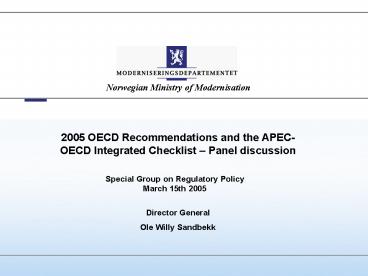PowerPointpresentasjon - PowerPoint PPT Presentation
1 / 7
Title:
PowerPointpresentasjon
Description:
Ole Willy Sandbekk. Special Group on Regulatory Policy March 15th 2005 ... Change attitudes/traditional views on the use of regulatory instruments in bureaucracy ... – PowerPoint PPT presentation
Number of Views:21
Avg rating:3.0/5.0
Title: PowerPointpresentasjon
1
2005 OECD Recommendations and the APEC-OECD
Integrated Checklist Panel discussion
Special Group on Regulatory Policy March 15th 2005
Director General Ole Willy Sandbekk
2
What policy challenges for investment, innovation
and productivity will these measures help address?
- NORWAY
- Good governance perspective
- Change attitudes/traditional views on the use of
regulatory instruments in bureaucracy - Support the use of appropriate regulatory
alternatives (vs basic regulatory needs) - Reduction of administrative burden on business,
citizens and public sector - Increase adequacy, efficiency and effectiveness
in the use of resources - Remove hindrances to innovation
- Coordination between ministries and agencies
- Better basis for political decisions through
improved RIAs
3
What steps are countries taking to increase the
capacity for regulatory quality?
- NORWAY
- Coordinate and strengthen use of RIA at central
government (Expert Panel) - Strengthening the role and autonomy of regulators
and supervisory agencies - Stimulate political support for reform
- Information/education of officials
- Monitor the performance of ministries survey
prepared by Min. of Modernisation
4
What should be the key elements in a good
regulatory process?
- A point of view
- Identify objectives avoid too many
- Assess regulatory instrument options as part of
RIA - Economic, legal, structural (simplification),
organisational(quality models/standards) or no
regulation - Select the most approporiate instrument/combinatio
n of instruments - Consider risk analysis as part of initial RIA
- Consult- use virtually based communication
- Recommendation and decision
- Evaluation. Test assumptions and conclusions of
RIA.
5
What benchmarks will make progress apparent?
- Possibilities in general
- Measure over time
- Surveys of regulatory burdens, e.g. the OECD
Business Survey - Expert-based measurement of administrative
burdens, e.g. the Standard Cost Model - Registers of obligations or licenses, e.g. the
Register of Reporting Obligations for Enterprises
in Norway - Indicators of formal regulations and policy. E.g.
Product Market Indicators (OECD) - The extent of use of regulatory alternatives
- Econometric models with regulatory variables
- Comparative analysis of countries
6
How can the gaps between the most advanced and
other (OECD)countries be reduced?
- Be aware of cultural/political differencies
- Knowledge Management/ Virtually based cooperation
in networks - Exchange of experts
- Role of OECD/2005 Recommendations/APEC-OECD
Integrated Checklist - Bear in mind Outcome(Welfare, GDP etc) is the
goal, not the regulation as such
7
What are the most significant regulatory problems?
- A personal point of view
- Public governance/public sector
- Use of alternatives to traditional regulation
- Bureaucaratic culture/traditions































